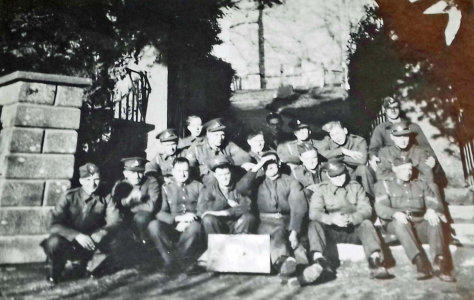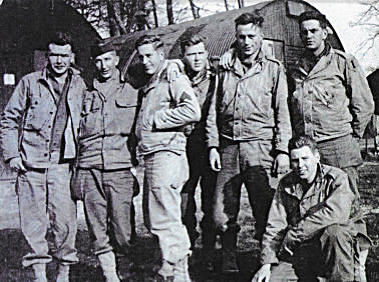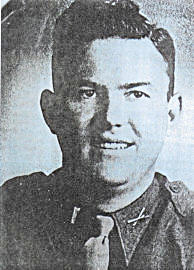D-DAY 80 - THE BRIDE VALLEY IN WW2
Litton was the centre of training for a succession of units both British and American for four years. The 8th battalion of the Essex
Regiment was stationed in the area and had its H.Q. in the village.
The nucleus of the troops’ billets were 28 Nissen huts in the two fields east of the school (there were then no houses in the lane,
other than the schoolhouse). This was supplemented by the taking over of the bams at the Rectory and at Court House. The Youth
Hostel (as popular during the 1930s as it is today) became a sick bay and general H.Q. office. The buildings and yard of Cross Tree
Farm (where Moxom’s factory was) was commandeered for workshops and stores and a general assembly area. The Foot family
who owned the farm continued to run it from their other farm at Long Bredy.
In 1939 the 257th Battery, Royal Artillery, trained here before
active service, many of them subsequently losing their lives at
Dunkirk. The picture of some of them sitting on the church steps
was taken by Eric Davis, one of the 42 men billetted in the old
Sunday School. Others werre housed at White Cross; Glebe
Cottage was used as the officer’s mess. The area in front of the
bus shelter was used as their parade ground.
The entry of the U.S.A. into the war brought American troops
into the area which became involved in the preparation for the D
Day landing in Normandy. Litton had a distinguished visitor in
1943 when General Eisenhower, the Allied Commander in
Europe, decorated men who had come back from the invasion of
Italy. The investiture took place in Cross Tree farmyard but for
security reasons did not become generally known until after it
had taken place.
One must not forget the Home Guard. Both Litton and Long Bredy had small platoons right from its early days, generally under the
command of officers or N.C.O.s who had First World War experience. Gradually, through 1940 when invasion seemed imminent, it
gained in organisation and efficiency so that by 1944 it was considered part of the line of defence. One can however, remember
experiences of those early days such as being taken to Kingston Maurward to fire two rounds from a rifle “to get the feel of it”. For
the Home Guard platoons the invasion scare in 1940 meant assembling in the evening in Puncknowle school, each with just one
clip of five rounds for his rifle, ostensibly to back up the regular units defending the beach.
A detailed diary of the second world war in Litton Cheney can be read here
With the successful invasion of Europe, troops were gradually withdrawn from the south coast area and the Bride Valley no longer
had the visitors it had entertained for almost four years. In Litton. The camp in School Lane was demolished save for the two
Nissen huts which had been the sergeants’ mess. These were to serve the school as a kitchen and dining room for another 23
years. The fine bam in the grounds of Court House had, however, been burnt down never to be rebuilt. Litton gradually regained its
peacetime calm but, of those who served, seven did not return, their names being added to those on the 1914-18 memorial in the
churchyard - details here
HISTORIC ARCHIVE
ABOUT LITTON CHENEY






Photo by Claire Moore 3_7_2021


PARISH COUNCIL
ABOUT LITTON CHENEY
VILLAGE FACILITIES
LOCAL SERVICES
VILLAGE INFORMATION
Litton Cheney
Long Bredy
One Man's D-Day Remembered - 80 Years Ago
The photograph is of some American soldiers, part of L Company, 3rd Battalion, 16th Infantry Regiment, who were stationed in
Long Bredy from November 1943 to the end of May 1944.
One of them was Jimmie Walters Monteith who, amongst many others, was based for several months
in the Bride Valley, in the lead up to the D-Day Landings.
First Lieutenant (Infantry)Jimmie Waters Monteith was posthumously
awarded the Medal Of Honor by The President of the United States for
conspicuous gallantry and intrepidity above and beyond the call of duty
on 6th June 1944. He was 27 years old. He is buried at the American
cemetery in Colleville-sur-Mer, Normandy in France.
Prior to D-Day, from November 1943 Jimmie and his division were
based in Long Bredy preparing for the Normandy invasion. The soldiers
were billeted in a collection of wooden Nissan huts located on the village
playing field and The Rookery.
During this period the Bride Valley would be the location for many
American soldiers and no doubt for that period they became very much
part of the local scenery and life in the valley. They would have used the
local pubs, helped out generally, went to the village churches and
attended local events. Our country lanes now used to giant HGV's exploiting their narrowness would have witnessed hundreds of
military vehicles heading in various directions. Practice landings would have been carried out on our local beaches, and at certain
times during exercises, curfews would have been in operation.
This is just a taste of what went on at the time. It references one man's war, a war that he sadly was not able to see through to
victory in 1945. We honour his memory and ultimate sacrifice, and that of so many others.
The planning for an invasion in northwest Europe began years in advance, although it was not until December 1943, when
General Dwight D. Eisenhower was appointed Supreme Commander of the Allied Expeditionary Force, that preparations for the
future operation, code-named Overlord, intensified.
D Day holds particular significance for Dorset as the county was in the front line of the build up to the invasion of Europe.
Soldiers from America, Canada, and France, as well as British troops were stationed across Dorset, with many areas becoming
militarised zones. The coastline became a rehearsal stage for the planning of the event and, in the seas off the coast, the fleet
was assembled.
In 1943 the cliffs between Hive Beach and West Bay were used by the American Cliff Assault Team, alongside Canadian and
British troops, in preparation for the D-Day landings. On the 5th June 1944, the sea was filled with boats, so much so you
couldn’t see the sea at all. On the cliff edge is a pill box, its little windows providing a perfect view across the coastline. The
beaches during this period were also covered with barbed wire and cement dragons’ teeth, some of which still remain on Chesil
Beach.
Weymouth and Portland saw the biggest embarkation of men and equipment, primarily American. Nearly half a million men and
140,000 vehicles passed through these two ports. Portland was described as the “biggest little port in the world” by the Americans.
They were headed towards ‘Bloody Omaha’ where the heaviest losses were suffered.
Thus, the county of Dorset became a temporary home for thousands of GI’s as the American troops were known, not least here
in the Bride Valley.

Jimmie Waters Monteith Jr.
Jimmie Waters Monteith Jr. was born on July 1, 1917 in Low Moor, Virginia. His family moved to Richmond, Virginia, when he
was nine years old. After elementary school, he attended Thomas Jefferson High School, where he played a year each of varsity
football and varsity basketball. Known in high school as "Punk," he graduated in 1937. He attended Virginia Polytechnic Institute
and State University (VPI) for two years, 1937–1939, majoring in mechanical engineering. While at VPI, he was a member of K
Battery in the Corps of Cadets, The prestigious G.E.R.M.A.N. Club of VPI and the Richmond Sectional Club. He returned to
Richmond at the end of his sophomore year and worked as a field representative for the Cabell Coal Company, where his father
was vice president. He was drafted into the army in October 1941 and sent to Camp Croft, South Carolina, for basic training.
During basic training, he was promoted to corporal and applied for officer training. He was accepted and sent to Fort Benning,
Georgia, completing the course in March 1942, when he was commissioned a 2nd lieutenant. He was then transferred to Fort
McClellan, Alabama, where he helped train the 15th Battalion. In February 1943, he was transferred into the 30th Division at
Camp Blanding, Florida, to begin training in preparation for being shipped overseas to fight in the war.
In April 1943 he was shipped to Algeria, where he joined the 1st Infantry Division (Big Red One). The division moved to Sicily in
July 1943, and he received a field promotion to 1st lieutenant during the campaign. The division moved to England in November
1943 to prepare for the Normandy invasion and he was based in Long Bredy.
He is buried at the American cemetery in Normandy, Colleville-sur-Mer, Basse-Normandie, France. His grave can be found in
section I, row 20, grave 12.
The President of the United States in the name of The Congress takes pleasure in presenting the Medal of Honor (Posthumously)
to FIRST LIEUTENANT (INFANTRY) JIMMIE W. MONTEITH, JR. UNITED STATES ARMY for service as set forth in the
following CITATION:
For conspicuous gallantry and intrepidity above and beyond the call of duty on 6 June 1944, while serving with 16th Infantry
Regiment, 1st Infantry Division, in action near Colleville-sur-Mer, France. First Lieutenant Monteith landed with the initial assault
waves on the coast of France under heavy enemy fire. Without regard to his own personal safety he continually moved up and
down the beach reorganizing men for further assault. He then led the assault over a narrow protective ledge and across the flat,
exposed terrain to the comparative safety of a cliff. Retracing his steps across the field to the beach, he moved over to where two
tanks were buttoned up and blind under violent enemy artillery and machinegun fire. Completely exposed to the intense fire, First
Lieutenant Monteith led the tanks on foot through a minefield and into firing positions. Under his direction several enemy
positions were destroyed. He then rejoined his company and under his leadership his men captured an advantageous position on
the hill. Supervising the defense of his newly won position against repeated vicious counterattacks, he continued to ignore his
own personal safety, repeatedly crossing the 200 or 300 yards of open terrain under heavy fire to strengthen links in his defensive
chain. When the enemy succeeded in completely surrounding First Lieutenant Monteith and his unit and while leading the fight
out of the situation, First Lieutenant Monteith was killed by enemy fire. The courage, gallantry, and intrepid leadership displayed
by First Lieutenant Monteith is worthy of emulation.
































